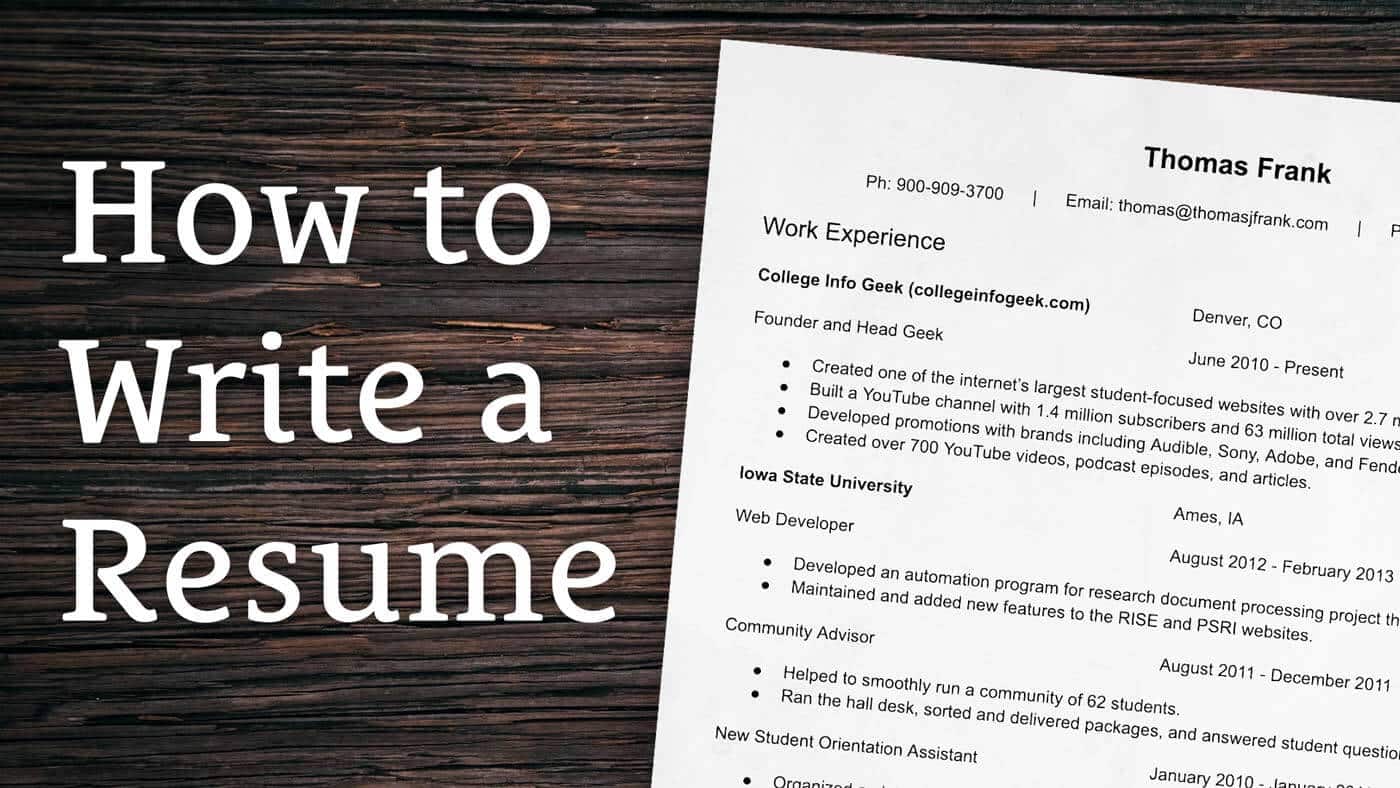I don’t think anyone enjoys writing resumes. They can feel like pointless exercises in self-glorification at best, and exercises in the fine art of b.s. at worst. You have to take all the things you’ve done over the past 1-5 years and condense them into a 1-page document that will (hopefully) convince a person with hiring power to give you a job.
With all this pressure, all this confusion, it’s easy to just plug some random facts about yourself into one of those online resume generators and call it a day.
But it doesn’t have to be like that.
I can’t promise you that I can make writing a resume fun, but I can show you how to do it as painlessly as possible. More importantly, I can show you how to write the resume that will cut through the stack of hundreds (or thousands) and get you that job, internship, or other opportunity you want.
In today’s post, I’m going to give you the lowdown on resumes. I’ll start with an explanation of what a resume is and why it’s important. Then, I’ll cover some common questions about resumes. Finally, I’ll show you how to create the perfect resume for the position you’re applying for (and how to stand out from the crowd).
Let’s get started!
What Is a Resume?
As I was researching this article, I realized that I didn’t know anything about the history of the resume. It’s such an accepted part of life these days that, much like the internet or pizza bagels, it’s easy to forget that it’s a recent invention.
Of course, how recent of an invention it is depends on what you define as a “resume”. The word comes from the French résumé, meaning “summary”. If we define a resume as a summary of job skills and experience, then the first resume dates from a letter that Leonardo da Vinci wrote to a potential employer between 1481 and 1482.
Resumes as we know them today, however, didn’t come into existence until the mid-twentieth century. By the 1970s, they looked much the way they do today: professionally formatted summaries of skills and experience that were expected with any job application.
Before this point, resumes did exist, but they were much more informal, often scribbled on scraps of paper. They also included information that would be, well, inappropriate on a modern resume such as height, weight, marital status, and religion.
To read a full, ahem, résumé of the resume’s history, check out this timeline from Business Insider.
So what purpose does a resume serve these days? After all, can’t potential employers just look up your skills and experience on your personal website or LinkedIn profile?
They can, and in some cases job applications will require you to apply with your LinkedIn profile. And it’s always a good idea to include a link to your personal website as part of your resume.
Still, the resume as a standalone document remains a key part of most job applications.
So why is your resume so important? Let’s have a more detailed look.
Why Resumes Are Important

Resumes matter because they show a potential employer two crucial things:
1. A Quick Summary of Your Experience
This is the most obvious function of the resume, but from an employer’s perspective it’s invaluable. If a job lists specific experience requirements or a minimum GPA, then it’s easy to filter out resumes that don’t include them.
It can also show the breadth of experience you have and even, in some cases, signal your qualifications. Someone who went to a prestigious school or interned at a prestigious company, for example, looks like a more qualified candidate (even if that isn’t actually the case).
2. Your Writing Skills
You might think that a cover letter is the best demonstration of your writing skills to a potential employer, but your resume also showcases key writing abilities.
It displays your ability to condense a large body of information into a concise, 1-page document.
It shows that you can organize information in a logical manner.
And, of course, a resume that’s free of spelling and grammatical errors shows that you’re careful enough to proofread and pay attention to details (more on the importance of proofreading later on).
5 Sections That Every Resume Should Include
We get into the nitty-gritty details of resume creation later in this guide. But if you just need a quick primer on what sections your resume should have (and what to include in each section), here’s a brief breakdown:
1. Work Experience
Your work experience is crucial for helping a potential employer decide if you’re qualified for the job.
When listing work experience, we recommend you use the following format:
- Name of company
- City and state of company (and the country, if the job was outside your home country)
- Title of your position
- Dates you worked at the company (month and year is fine; no need to include specific days)
- Bullet points explaining what you achieved at the company
Here’s what this looks like in a real resume:

Filling in most of this information is easy, but the bullet points explaining your achievements are where some people run into trouble.
Specifically, many people make the mistake of just describing their “official” job duties. However, this tells a potential employer nothing about what you actually did at the company.
To make this information more useful, highlight your achievements, not your duties. If you can include numbers and statistics to back up what you achieved, all the better.
For instance, take a look at Thomas’s sample resume. He doesn’t just say, “Built a YouTube channel.” You could say that even if you had a channel with zero subscribers.
Instead, he gets specific and says, “Built a YouTube channel with 1.4 million subscribers and 63 million total views.”

If I were a potential employer, those numbers would get my attention. I’d want to interview such a candidate just to hear more about how they managed to get so many views and subscribers.
Note: In addition to formal “jobs” at companies, your Experience section can also include any cool personal projects you want to highlight (such as your website).
2. Education
Up next, you should include a section summarizing your highest level of education. That’s right — if you went to college, then no one cares where you went to high school. The only exception is if you have a master’s or professional degree. In that case, put that before your undergrad info.
Here’s the format we recommend for listing your education:
- Name of educational institution
- City/state of school (and country if you earned the degree abroad)
- Degree you earned, followed by the field you earned it in
- Date you earned your degree (if you’re a recent graduate)
- GPA (optional)
Here’s an example:

In general, I don’t recommend including your GPA if it’s lower than a 3.2. If you include a low GPA, you’re unnecessarily making a bad impression.
3. Skills
The skills section is your chance to showcase anything you can do that would make you more qualified for the job. To list your skills, just use this format:
- Category of skill: Specific skill name
Here’s an example Skills section:

When writing the Skills section, the most important things to keep in mind are:
- Make sure the skill is relevant — If you’re applying for a job in corporate HR, for instance, then your spearfishing certification doesn’t matter.
- Make sure it’s actually a skill — Specifically, you want to include hard skills. Examples include software you can use, languages you can speak, and processes you know how to perform. Leave out soft skills, such as “good communicator” or “great leader.” You can demonstrate these during the interview.
For more tips on skills, skip to this section of the article.
4. Extracurriculars and Leadership
If you just graduated, then this is a chance to add some additional experiences that weren’t technically “work” but that are relevant to the job.
This section can include formal extracurriculars and leadership positions at your university/in your community.
When listing extracurriculars and clubs, just use this format:
- Name of club and name of leadership position (if applicable), followed by the years you were in the club/held the position
Here’s an example Extracurriculars and Leadership section:
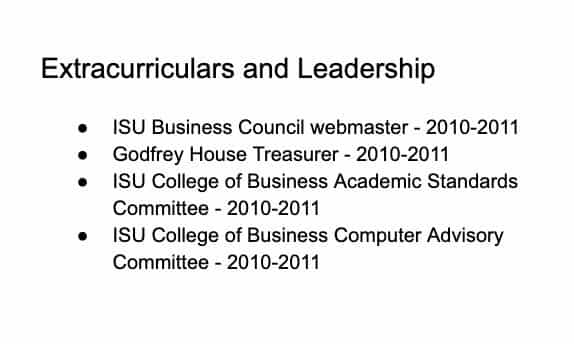
5. Honors and Awards
This last section is a chance to showcase any impressive honors or awards you received while you were in college (or even outside of college).
Here are some examples of things to include in this section:
- Scholarships
- Honor roll/dean’s list
- Fellowships/research grants
- Honor societies
If the honors and awards are relevant to the job, that’s even better. For instance, if you’re applying for an engineering position and you were part of your school’s engineering honor society, that’s definitely something to include.
Here’s an example Honors and Awards section:
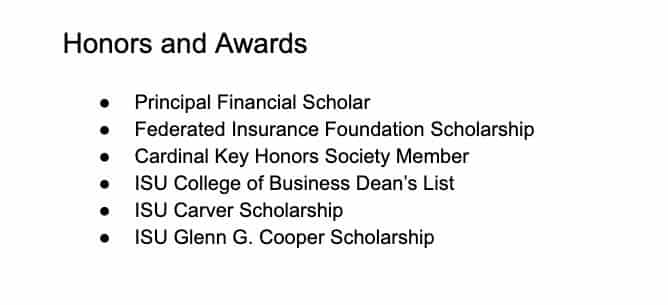
Common Resume Questions
Now that we understand why resumes are important, we can move on to some common questions students have when creating resumes.
Some of these are literal questions that I had when I created my first resume, and others are based on common problems I’ve observed when helping others create resumes.
1. Resume or Portfolio?
For some jobs, a resume may not be appropriate or necessary. In my field of freelance writing, for example, I very rarely have to submit a formal resume.
Potential employers are more interested in what I’ve done. They’ll usually request that I send them some links to previous work that fit the style or topics they want me to cover. But a summary of where I’ve worked and for how long isn’t normally relevant.
The same is true in a variety of other industries, especially for freelancers and creative professionals. If you’re applying for a job as a developer, your GitHub profile says far more than any resume ever could. For designers, the same is true of Behance.
That doesn’t mean resumes are gone, or that you’ll never need to submit a resume for a “creative” job. But it seems like the trend is moving more toward portfolios. Which is why it’s so important to have a personal blog or website where you can showcase your work to any interested party.
Above all, just pay attention to the requirements for the specific job–they’ll indicate whether you need to submit a resume, portfolio, or other materials.
2. How long should my resume be?

I know, I know, you’re reading College Info Geek. Which means you probably have more badass achievements and experience than the average person. But that doesn’t mean it’s okay to create a 5-page resume…or even a 2-page one.
For most people reading this site, your resume should be one page, no longer. If you have more than five years professional experience, then it can be appropriate to add an additional page, but I’d avoid it in most cases. Unless you’re a senior-level executive, your resume should not exceed one page.
If that feels too short, then don’t worry. We’ll address how to make all the relevant experience fit in a bit.
3. How “creative” should my resume formatting be?

In an attempt to stand out from the crowd, some students will print their resume on fancy paper, add colors and graphics, or even deliver their resume via carrier pigeon (okay that last one might be a stretch, but you never know).
There’s nothing wrong with any of these approaches per se, but in general I’d recommend you avoid them. If you’re a designer and know how to make a document that looks good and is easy to read, then by all means get creative with the design of your resume–it can be a chance to show off your design skills.
For most students, however, I suggest you stick to black Arial or Times New Roman on a white background. Especially if you’re submitting your resume digitally, this ensures that the potential employer will have no trouble reading it.
In some cases, of course, the job application will ask you to include an unconventional resume such as a video or webpage. If that’s the case, then go for it! (even if it’s “optional”).
4. How should I format my resume?
I said you should go with black Arial or Times New Roman on a white background, but that neglects all the other details of formatting the resume. How should you structure it? What size font should you use? Do you put your contact information at the top or bottom?
Instead of trying to give one “right” answer to these questions, I’ll suggest that you use one of the thousands excellent resume templates that are already on the internet. Here are a few that will work for almost any job:
- Classic Resume Templates via Resume Genius
- Resume Templates via Microsoft Word
- Google Docs Resume Templates via The Balance
One final formatting tip: unless the job application indicates otherwise, submit your resume as a PDF. This will ensure that the recipient can view it with the formatting you intended no matter what operating system or software they use to open it.
5. Can I reuse the same resume for different job applications?
Well, yes and no. It’s fine to use the same template and structure for different job applications in order to save time. But you should always tailor your resume to the specific job.
In fact, not tailoring your resume to the specific position is one of the most common resume mistakes. Hiring managers can spot a generic resume from a mile away, so put in the effort to include experience and skills relevant to this job, not any job.
6. What should I include in my resume?

I already told you your resume should be just one page, so what do you include? Taking all of your experience and condensing it into one page can be overwhelming. The key is to pick the most relevant experience.
For example, let’s say you’re applying for an internship at a law firm. Naturally, you won’t have worked in a law firm before–that’s the whole reason you’re getting the internship.
But you can consider your previous jobs and how experiences in them would relate to what you would do at a law firm internship.
A job working the front desk in your dorm, for example, has within it all kinds of potentially relevant experiences. A job like that teaches you how to be professional, how to answer the phone, how to deal with conflict, and how to keep a disciplined schedule. All of which could be relevant to the law firm internship.
7. What is a skill?
Okay, so no one has ever straight up asked me this question, but there’s definitely some confusion about what a “skill” is when it comes to resumes. So let’s get something clear: a “skill” is a specific technical ability you have.
These are not skills:
- “Good communicator”
- “Great listener”
- “Hard working”
Yes, they may be soft skills, but your resume is not the place for soft skills. Show off your soft skills in the interview.
These are skills:
- React development
- Photoshop image editing
- Bow hunting
If you’re not sure if something is a skill, then leave it out.
And please, please don’t include a skill you don’t have. Your employer will find out and it will be awkward. Especially if it’s claiming you speak a certain foreign language at an “advanced” level when in reality you took one semester of it as a freshman.
8. What if I don’t have any experience?
When students say “I don’t have any experience”, that’s rarely the case. Unless you really did spend all of college sitting in your dorm eating cheesy puffs and playing Overwatch, you have something you can talk about. Sometimes you just need to think outside of the box.
Here are experiences/positions that could all be relevant to a resume:
- Part-time jobs (on and off campus)
- Sports teams (varsity or intramural)
- Any kind of leadership position for a club, athletic team, student government, or community organization
- Internships
- Self-employment/freelancing/starting your own business (even if you “failed”)
- Volunteer experience
Now, in some cases if you’re finding that you just don’t have the right experience for a particular job’s requirements, then it may be worth considering a different position.
That being said, I encourage you to apply to jobs you don’t think you’re qualified for. The worst thing that will happen is the company will say no (or never get back to you).
If this happens, you haven’t wasted your time–far from it. You’ve gained valuable practice in applying for jobs, and you’ve also gained an idea of the skills/experience that would make you a better candidate in the future. As long as you learn from these experiences, they’re worthwhile.
How to Create an Outstanding Resume
We’ve already covered a lot about the art of creating a great resume, but I want to conclude with a list of things that will make your resume stand out from the rest of the pile (in a good way).
1. Proofread
This should go without saying, but you must proofread your resume. Spelling mistakes and typos make you look careless–and no one wants to hire someone who’s careless.
Go through all of the following proofreading steps:
- Read your resume out loud. Seriously, you’ll catch so many errors this way.
- Paste your resume into Grammarly. This is a free program that will catch all kinds of spelling, grammar, and usage mistakes.
- Get a trusted friend to read your resume. An extra pair of eyes will catch mistakes you would never see. Just make sure it’s someone who knows a thing or two about writing.
2. Seek Professional Help
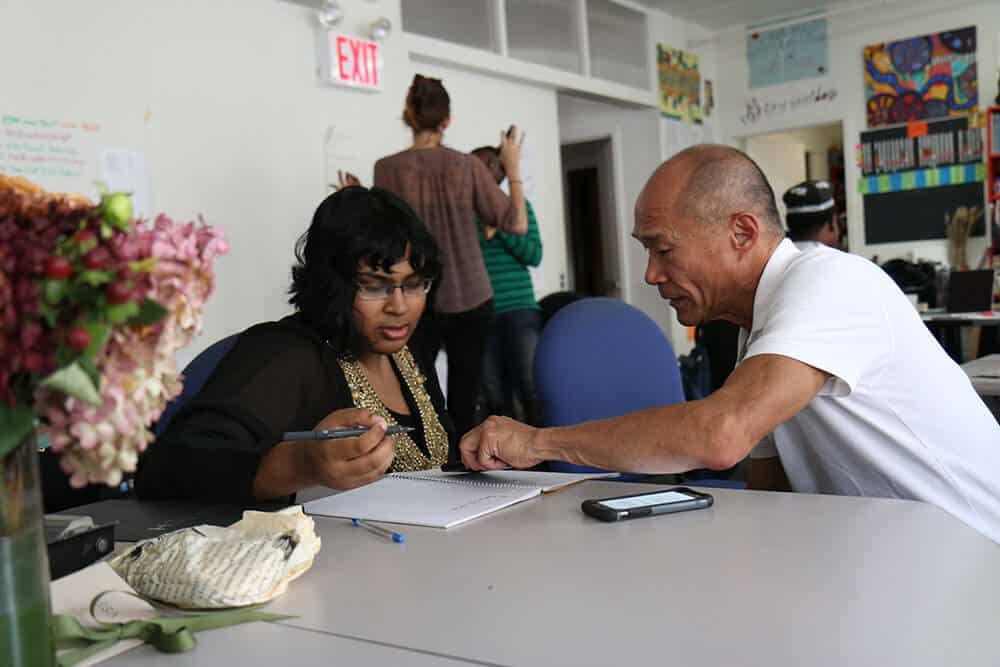
What if I told you that you could get a trained professional to read and critique your resume at no extra cost to you? Wouldn’t that seem too good to be true?
Well, you’re in luck, because that’s exactly the service you’ll find at your college’s career center. Enrollment at your university entitles you to free, basically unlimited help with making your resume the best it can be. You’re already paying for it, so you’d be a fool not to take advantage of these services.
Not to mention that the career center can also help you find jobs/internships, perform mock interviews, and generally give you advice on your post-college plans.
Pro tip: Make sure that you get help with your resume well before the application is due. That way the nice career planning folks will have plenty of time to help you.
3. Leverage Your Network

Of course, the best person to review your resume would be someone who already works in the company or industry to which you’re applying. Finding this sort of person might seem impossible, but the key is to look to the connections you already have.
There are a few ways to find industry professionals to review your resume:
1. Asking family and friends
You’d be surprised at the people your friends and family members know. Just shoot a quick text to your parents, aunts and uncles, cousins, whoever would be willing to help.
All you have to say is “Hi, I’m applying for a job at NAME OF COMPANY in NAME OF INDUSTRY. You wouldn’t happen to know anyone who works in a similar job?”
If they do know someone, then get them to introduce you and go from there.
And don’t think asking for help in this way is annoying. As long as you’re polite and genuine, people always love to help out college students and recent graduates.
2. LinkedIn
I only discovered this recently, but if I’d known about it when I was a student I totally would have used it.
First, log-in to LinkedIn. From there, click on “My Network”.
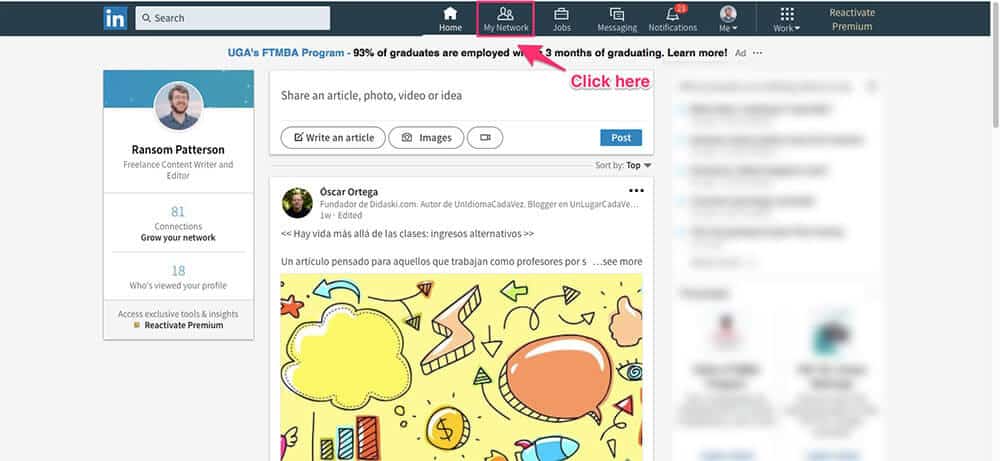
Then, click “See All” under “Your Connections”.
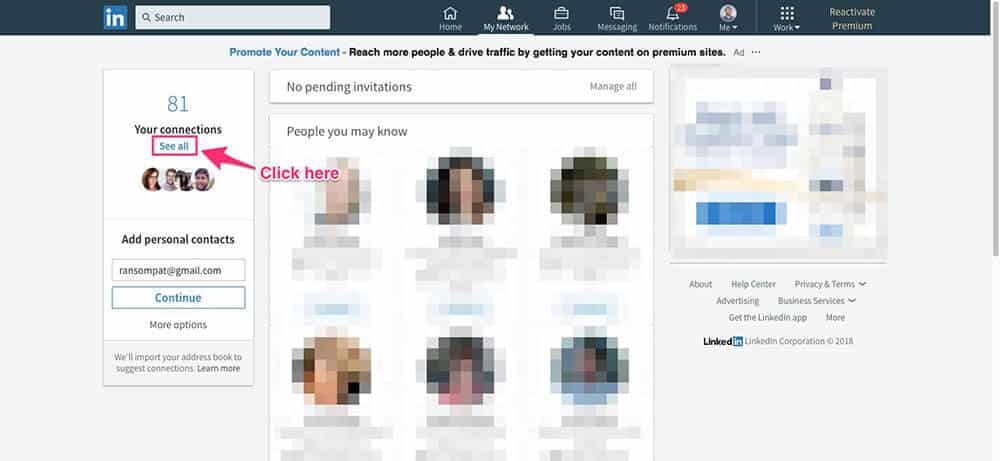
Next, click on “Search with filters”.
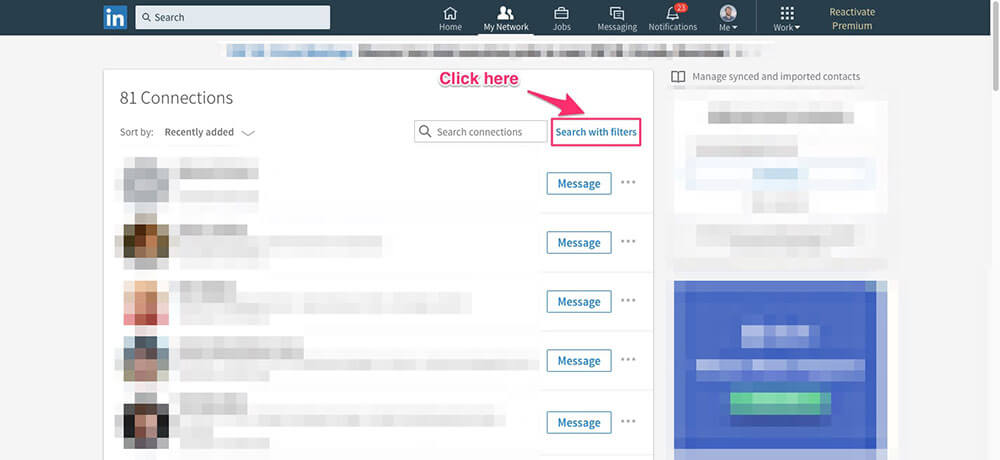
From there, you can filter your connections by all kinds of criteria. I recommend starting with “Keywords”, “Current Companies”, and “Industries” to find people who would be able to give your resume a review.
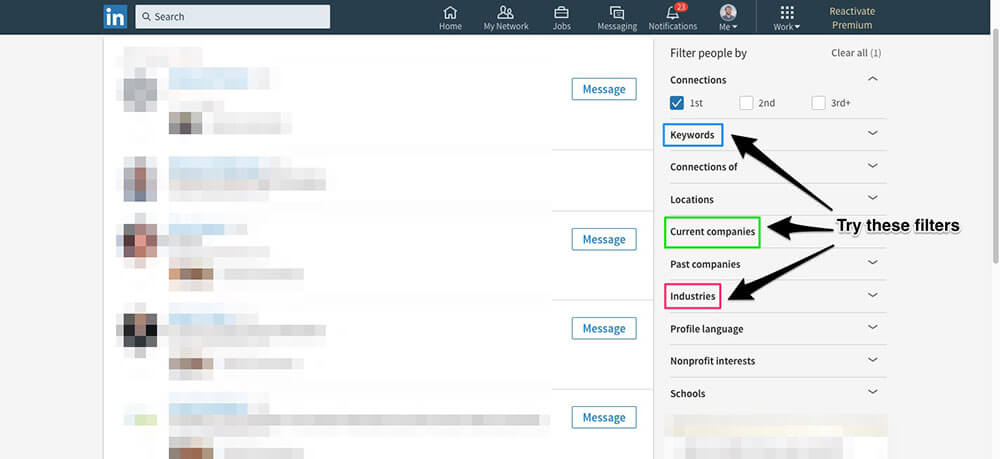
Once you find someone who looks like they could help, you just need to send them a message along the following lines:
Hi NAME OF PERSON,
I was just looking through my connections and noticed that you work at NAME OF COMPANY/NAME OF INDUSTRY. I’m currently applying for a job/internship/volunteer opportunity at NAME OF COMPANY/NAME OF INDUSTRY, and I was wondering if you’d be able to review my resume. As an aspiring professional in NAME OF INDUSTRY, I would be super grateful to get feedback from someone with your experience.
Thanks,
YOUR NAME
And if your LinkedIn and network in general seems a little scarce, here’s how you can start building your network today (even if you’re an introvert).
3. Job Fairs
Most colleges and universities have job or career fairs where representatives from companies come to find prospective job candidates, conduct interviews, and give career advice.
You should absolutely go to these and bring your resume along. If you’re smart, you’ll research which companies will be there beforehand and create a resume tailored to the particular companies that interest you. From there, you can get real industry professionals (with hiring power) to give you resume feedback.
A Sample Resume to Help You Get Started
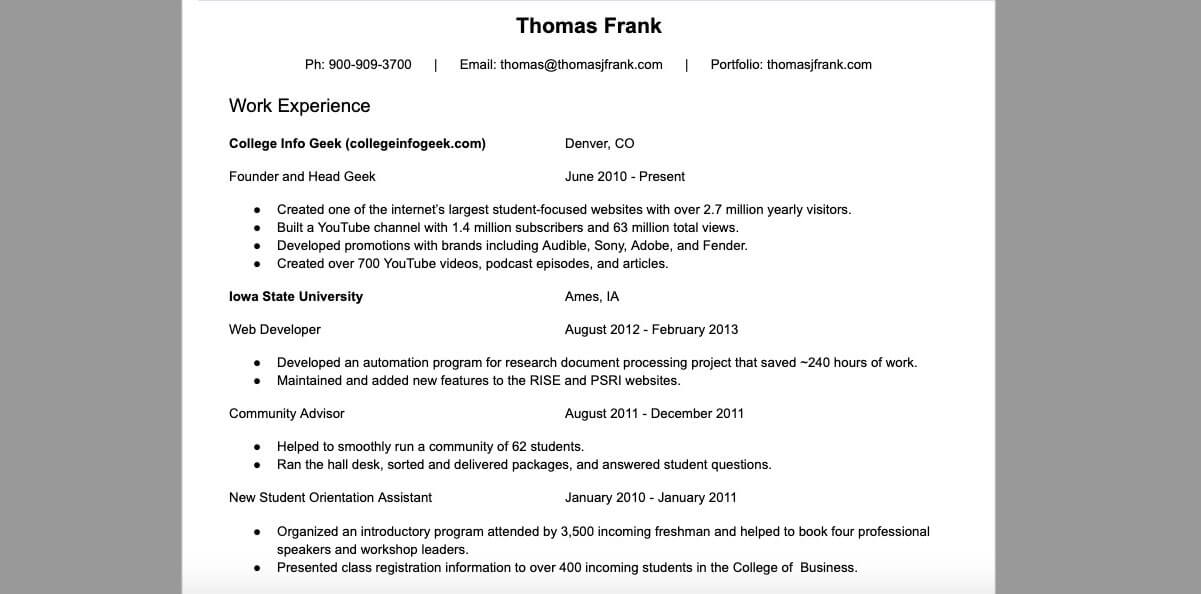
Okay, so now you know how to create a resume, but staring at a blank document can be intimidating. To help you get over writer’s block and start making your own resume, here’s a sample resume that Thomas created.
Feel free to make a copy of the document and fill it in with your own work experience, skills, and education. Just make sure to proofread carefully so that you don’t accidentally include any of Thomas’s information.
Here’s how to use the sample resume:
- Visit the resume link.
- To make your own copy of the resume in Google Docs, click on File > Make a copy and choose a name for the new file. You’ll now be able to edit in Google Docs.
- If you don’t have/don’t want to use Google Docs, then click on File > Download as and choose the file format you want to download. “Microsoft Word (.docx)” will be the best format for most people, as it will allow you to open the document in Microsoft Word.
Start Writing Your Resume Today
We’ve covered a lot of ground in this article. I hope you now feel equipped to write a resume that will get you the job you dream of…or at least that first entry-level job or internship that will put you on the career path of your choice.
If you take nothing else away from this article, remember that you can and should ask for help with your resume. You’ll learn so much, and you may even make a valuable professional connection in the process.
Updating your resume due to recent job loss? Read this next.
Image Credits: featured, papers on table, office workers, glasses on paper, glowing question mark, graphic design, checklist, pencil shavings, professional help, overhead view of common area


